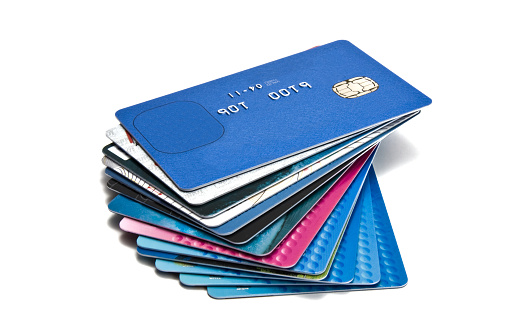When it comes to financial accounts, your interest rates typically play a big role. And if you’re the one paying the interest (rather than earning it), you’ve likely seen firsthand that it greatly affects your monthly bills. That’s especially the case with credit cards, which traditionally carry some of the highest interest rates among lending products.
In fact, the average credit card interest rate as of March 2019 was 17.85%.
“A higher APR will have a greater impact on the amount of interest you pay,” says Bruce McClary, vice president of communications for the National Foundation for Credit Counseling. “The higher the interest rate, the higher the cost of borrowing.”
But when you really dive into the complex topic of credit card interest rates, it could encourage you to make smarter borrowing and spending decisions.
“Interest rates can be like a trap,” says Scott Butler, a retirement income planner at Klauenberg Retirement Solutions in Laurel, Maryland.
If you become stuck with high-interest debt from month to month, he says, you’ll learn the hard way that it’s a painful way to borrow money.
Here’s a brief overview of what you need to know so you can overcome high interest rates for credit cards:
- What APR is.
- Why credit cards have more than one interest rate.
- How interest affects your credit card bills (and your total debt).
- How to avoid paying interest.
- Why interest rates change.
- What to do with your APR knowledge.
What Is APR?
APR stands for annual percentage rate, but you’re actually being charged interest daily, McClary says. Interest is calculated based on the “average daily balance” you have during a billing cycle, he explains. That’s typically between 25 and 31 days. In essence, each day’s balance total is added up, and then divided by the number of days in the billing period.
Then, using that amount, you can figure out how much you’ll actually pay in interest based on your APR. It involves taking the average daily balance times APR times days in a billing cycle and dividing by 365.
So say your average daily balance is $525, your APR is 14.99% and your billing cycle is 28 days. Under that scenario, the calculation would be:
$525 x 14.99% x 28 / 365 = 6.03
That is, you’ll be charged $6.03 in interest for that month.
Yes, the formula is a bit complex, but it gives you a better sense of the math behind APRs.
Why Credit Cards Have More Than One Interest Rate
Although the purchase APR is what most people think about when considering interest rates, credit cards actually have different rates for different types of transactions. In other words, even though you have one balance, it’s possible that portions of your balance have different rates.
The good news is this information is not hidden from you. Your credit card statement, as well as the terms and conditions of your card, breaks down the various APRs you are charged or might be charged. Here’s a brief rundown of the interest rates that might be charged on one of your credit cards:
Introductory APR
Many card issuers offer an introductory rate that is low or even 0% to entice you to choose their product. The benefit is that you can carry a balance without paying interest for a set period. It’s important to take note of when this rate expires and when the regular purchase APR kicks in.
Balance transfer APR
A balance transfer APR is applied to debt that you transfer from one card to another. In most cases, balance transfer cards offer a low or 0% introductory rate for a set period. In some cases, your existing credit card issuer might offer the opportunity to transfer a balance from another card at a promotional rate. Either way, if the balance isn’t paid by the rate expiration date, a new balance transfer APR will be applied to the remaining balance.
Cash advance APR
Using your credit card to essentially get a cash loan comes with a big price if you don’t repay it right away, thanks to the high cash advance APRs charged by most cards. These fees typically hover around 25%.
Penalty APR
If you’re behind on your bill for a specified time (for instance, two billing cycles), some cards might assess a penalty APR, which can be as high as 29.99%.
Here’s how APRs might play out.
You open a new account with a low introductory APR, but you fail to pay off the balance by the time the rate expires, so interest is charged on the remaining amount due. Next, you add a few more purchases, which are charged the regular APR. You also transferred another card’s balance to this card, so you’ve now got a balance transfer APR. And there was that time you took out a cash advance to cover emergency expenses, setting up yet another APR.
The result: Your total balance comprises of four types of transactions with perhaps four different APRs.
The good news for consumers is that ever since passage of the federal CARD Act of 2009, anything you pay above the minimum amount due first must go toward the balance with the highest APR. So in the scenario above, payments would be applied to the cash advance balance (which typically carries the highest APR) before the purchase or transfer balances. As for the minimum amount itself, the card issuer decides how it’s applied (and there’s a good chance it’s going to work in their favor, not yours).
How APRs Affect Credit Card Bills (and Total Debt)
If you’re carrying a balance, it’s likely because that high APR is doing its job – keeping you in debt. “When you make a payment on your card, a portion goes to the principal and a portion goes to cover the interest on the account,” McClary explains.
Unfortunately, if you’re paying only the minimum amount owed, the bigger portion of the payment is generally sucked up by the interest, meaning you won’t make much progress on reducing the principal.
That’s why McClary recommends looking closely at the minimum-payment warning on all credit card statements. “It demonstrates the length of time and how much it will cost you if you tried paying off your the account with only minimum payments,” he says.
As you can see in the above example (with a 14.74% purchase APR), paying just the minimum more than doubles the original balance — and takes 16 years to conquer.
How to Avoid Paying Interest
Now that you understand how APRs can affect your credit card balances, it’s time to learn how to make the most out of it. In other words, how can you still reap the benefits of credit cards without paying a penny of interest?
“The best way to get around a high APR is to pay off your balance as quickly as possible, preferably in full within the billing cycle,” McClary suggests.
To get the timing right, you need to understand when your card issuer charges interest. “It all depends on the grace period that your creditor gives you when you make a purchase,” McClary says.
A grace period is the amount of time you’re given to pay your balance off before interest begins to accrue. It’s the time between the end of the billing period and the due date.
Hypothetically, if you make a purchase right after a billing cycle ends, you could get close to two months to pay off that balance before being charged interest.
So, say your billing cycle ends on March 11 (also called the “statement date”) and your due date is April 1. That means the amount of a purchase made on March 12 wouldn’t be due until the next bill, or on May 1. As long as you pay for that purchase in full before April 1, you could avoid paying interest.
Just be careful, though. Grace periods vary, and issuers aren’t obligated to offer one at all, McClary points out. If there is one, the CARD Act says it must be at least 21 days. Also, if you revolve (or carry over) a balance month to month, issuers usually take away the grace period, meaning interest will immediately be applied to new purchases.
A good rule of thumb: Pay your balance in full each month on or before the due date to avoid interest.
Why Interest Rates Change
First off, keep in mind that there are two types of APRs for credit cards – fixed and variable.
“A fixed rate is not influenced by outside factors, but it can still be changed either by a decision that the credit card company makes or in response to things you have done with your account,” McClary says. (More on that in a minute.)
The issuer can decide to change the rate for any reason, but if it does, the issuer must notify you in writing.
By contrast, a card’s variable APR is based on the prime rate, which is tied to the Federal Reserve “benchmark” rate. It gets pretty technical, but what you need to know is that your credit card interest can fluctuate because of outside economic factors that you can’t control, McClary says. That’s why rates rose in 2018, for instance, when the Federal Reserve raised its benchmark rates four times. (FYI: They do this to keep inflation in check when the economy is growing.)
However, these rate changes are typically incremental (0.25%), so the effect is not life-altering. For every $1,000 of debt you’re carrying, you’ll pay an extra $2.50 a year for hike in the interest rate of 0.25%. So with four rate hikes of 0.25% each in 2018, interest charges would have amounted to an extra $10 for every $1,000.
Regardless of whether a card carries a fixed or variable APR, there are things you do that can cause the APR to change.
On the positive side, you might be able to negotiate with the card issuer for a lower APR.
“If your credit is fairly good, there is a decent chance you could get them to lower your rate,” Butler says. “Creditors would rather see you pay a smaller amount than to lose your business entirely to a competitor.”
On the flip side, if you miss payments or push your balance over the credit limit, it can trigger a penalty APR that’s higher than the APR.
What to Do With Your APR Knowledge
Hopefully, this guide piqued your interest (pun intended) in turning the tables on high APRs. To minimize the effect of high-interest debt, follow these four guidelines:
Keep your credit healthy
Whether you’re shopping around for a credit card or contacting your current card issuer to negotiate a better APR, a higher credit score puts you in a great position to score a lower rate.
Shop around
If you’re in the market for a new credit card, read the fine print about the card’s APRs, including the promotional rates. Don’t settle on the first offer you come across.
If you’re in debt, break the cycle ASAP
“If you’re carrying a balance of $1,000 or more, try adding as much as you can to the minimum payment,” McClary advises. “If you can double or triple it, do it – you’ll make much faster progress.” Or look into moving your debt to a 0% balance transfer card to help reduce your debt.
Ultimate goal: Don’t pay interest
Resist spending beyond your means. That way, you can more easily pay off credit card balances in full every month — and avoid getting hit with interest.
Additional Insights from the Quicken Compare Team
What are low-interest credit cards?
These are cards that have APRs that have a lower-than-average APR or have 0% introductory offers for a period of time on balance transfers and purchases. These low-interest cards are perfect for large purchases and balance transfers. 0% introductory APR credit cards are available to new cardholders making a purchase or transferring balances but will begin to have monthly payments once the promotional period is over. You typically need good credit to qualify for the best low-interest credit cards, but average credit can qualify for some cards as well. Outside of your credit score and your credit report, credit card issuers will also look at your DTI or debt-to-income ratio.
For balance transfer credit cards specifically, once you are approved you will typically have a certain time frame to complete the transfer in. This is usually 60-90 days. If you miss any payments or have late payments in this transfer stage, you can get hit with late fees, affecting your credit score. Financial institutions institute balance transfer fees in three ways:
- % Of the balance transferred
- Typically, 3-5%
- Minimum flat fee
- Typically, $5-$10
- No fee
- The best one! The credit card issuer doesn’t charge for balance transfers.
Now for the low APR cards. The average APR for all credit cards comes in around 17%-24% (according to US News). Low-interest credit cards are perfect for those that need a low APR for big purchases and times of monetary need. Ideally, these consumers could qualify for a 0% introductory APR balance transfer offer to transfer the credit card balance of their current high APR card to a card with a lower interest rate. It’s important to note that the transferring of debt from a low-interest card still incurs interest, but may be better than paying that interest with the other card at a higher rate.



